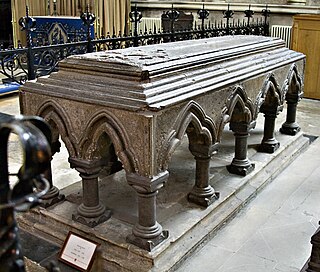Related Research Articles
Robert of Ghent or Robert de Gant was Lord Chancellor of England and Dean of York in the 12th century. The younger son of a nobleman, Robert was probably a member of the cathedral chapter of York before his selection as chancellor by King Stephen of England in the mid-1140s. He is not mentioned often in documents from his time as chancellor, but why this is so is unknown. He became dean at York Minster around 1147. Robert was slightly involved in the disputes over who would be Archbishop of York in the late 1140s and 1150s, but it is likely that his chancellorship prevented his deeper involvement in diocesan affairs. He was no longer chancellor after the death of Stephen, but probably continued to hold the office of dean until his death around 1157 or 1158.
John Chishull or John de Chishull was Lord Chancellor of England, Bishop of London, and Lord High Treasurer during the 13th century. He also served as Dean of St. Paul's.

Sewal de Bovil was a medieval Archbishop of York.
William Langton was a medieval English priest and nephew of Archbishop Walter de Gray. William was selected but never consecrated as Archbishop of York and Bishop of Carlisle.
John Climping was a medieval Bishop of Chichester.
Ralph Walpole was a medieval Bishop of Norwich and Bishop of Ely.
Richard of Gravesend was a medieval Bishop of Lincoln.
Henry of Sandwich was a medieval Bishop of London.
Richard Gravesend was a medieval Bishop of London.
The Archdeacon of the East Riding is a senior ecclesiastical officer of an archdeaconry, or subdivision, of the Church of England Diocese of York in the Province of York. It is named for the East Riding of Yorkshire and consists of the eight rural deaneries of Beverley, Bridlington, Harthill, Howden, Hull, North Holderness, Scarborough and South Holderness.
William Scot was a medieval Bishop of Durham-elect.
Fulke Lovell was a medieval Bishop of London-elect.
The Archdeacon of Brechin was the only archdeacon in the diocese of Brechin, acting as a subordinate of the Bishop of Brechin. The archdeacon held the parish church of Strachan as a prebend from at least 1274.
The Archdeacon of Cambridge is a senior ecclesiastical officer in the Diocese of Ely. The archdeacon is responsible for some clergy discipline and pastoral care in the Archdeaconry of Cambridge.
The Archdeacon of Berkshire is a senior ecclesiastical officer in the Church of England Diocese of Oxford. The archdeacon is the head of the archdeaconry of Berkshire, a post historically found within the diocese of Salisbury, and then, from 7 October 1836, within Oxford diocese.
The Archdeacon of Bath is a senior ecclesiastical officer in the Church of England Diocese of Bath and Wells. The post, having oversight over the archdeaconry of Bath, has existed since the twelfth century. The archdeaconry includes five deaneries.
The Archdeacon of Leicester is a senior ecclesiastical officer in the Church of England Diocese of Leicester.
The Archdeacon of Buckingham is the senior ecclesiastical officer in charge of the Church of England in Buckinghamshire.
The Archdeacon of the Isles was the only archdeacon in the diocese of the Isles, acting as a subordinate of the Bishop of the Isles. The number and names of the prebends, if any, associated with the archdeaconry in the later Middle Ages are not known. Before the break-away of the diocese of Man during the Western Schism, the archdeacons held Kirk Andreas as a prebend. The office seems to have fallen into disuse after the time of Alasdair Caimbeul, who received crown presentation to the position in 1592. It was to be revived in 1662.
Hamo was a 12th- and 13th-century English cleric. He was the Diocese of York's dean, treasurer, and precentor, as well as the archdeacon of East Riding.
References
- ↑ Lisburn Cathedral
- ↑ Alumni Oxonienses 1500-1714 Thoren-Toze
- ↑ Horn, Joyce M. (2003), Fasti Ecclesiae Anglicanae 1541–1857, 10, pp. 14–16
- ↑ "Fasti Ecclesiae Hibernicae: The succession of the prelates Volume 1" Cotton, H. p252 Dublin, Hodges & Smith, 1848–1878
| This article about an Irish Anglican cleric is a stub. You can help Wikipedia by expanding it. |